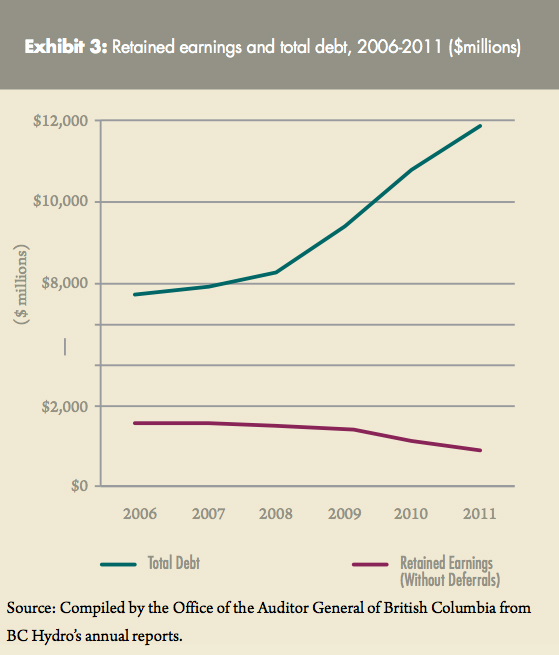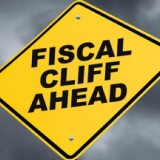The Government of BC has been on a borrowing and spending spree for about eight years. A lot of this is being done using the “Public-Private Partnership” model (P3) of which the former Premier Campbell was exceedingly fond. In fact, he was such a leading proponent in Canada that the commercial interests behind the use of the P3 approach made him theirhonourary chairman.
The associated debt from all this activity has been shielded from the public’s view. It was and is about pretending that long-term contracts are not the same as long-term debt, hence not needing disclosure as such.
At the end of fiscal year 2003/04 (March 31, 2004), total provincial long-term debt was reported to be $37.735 billion and total liabilities $52.951 billion. The latter figure includes the long-term debt at the time, plus another roughly $15 billion in other contractual commitments such as current year payments towards P3 infrastructure projects like highways, bridges and public transit projects. By fiscal 2012 the two values were $50.193 billion and $70.358 billion, respectively. Since a liability is something we all easily understand, that means, according to the “unaudited” statements of our Government, our liabilities increased by 33% over the nine year period.
To be clear, the current year figure does not represent our total long-term non-debt liabilities. That would be akin to one’s total credit card debt, while the current year figure would represent the annual interest payments due on that card. BC’s total contractual obligations, for things like private river power projects (IPPs) and P3 projects, stood in 2011 at over $80 billion dollars (again, on top of the over $50 billion provincial debt) – a remarkable increase of $46 billion in just five years. In a 2011 report, the Auditor General highlighted this troubling figure, stating, “In our view, government should be providing better disclosure of these obligations.”
Over the period of 2003/04 – 2011/12, our provincial GDP increased by 45%. Not too shabby, even after accommodating the “dead cat bounce” of fiscal 2011/ 2012. What about total revenues in the same period? They were reported to have increased by 41%.
So why the inability to achieve a balanced budget in the past four years and now?
The most obvious answer to this question is a problem of accounting and full disclosure. BC’s Auditor General John Doyle reports to the Legislature annually. His task is to examine the proffered financial statements and judge them as to their being in compliance with the appropriate accounting standards or not. Non-compliance is signaled by his use of the term “qualified”. In his report dated December 2012, Doyle indicates, “While qualified audit opinions are rare in the private sector, government has had 13 audit qualifications in its summary financial statements in the last 17 years.”
Being such a polite person, the A G passes over the fact that since first coming into Government, the Liberals have never made an acceptable accounting report. It is exceedingly difficult understanding the public’s tolerance of this kind of devious behavior.
So where does that leave BC citizens? Somewhat ill-informed is the easy answer – and perhaps a bit nervous as well.
An example of the problem of non-disclosure is at BC Hydro. A consequence of the Government creating the impression of a pending electricity deficit has caused the corporation to contract with private interests (IPPs) to provide electricity. Supporting this has been energy demand outlooks that invariablyproved themselves to be serious exaggerations with the passing years.
The provincial recorded domestic demand has hovered at about 50,000 GWhrs per year over the past decade. From IPP contracts, BC Hydro now takes in about 15,000 GWhrs that it previously provided from its own generation facilities. By this mandated program, the Government of BC has caused about15,000 GWhrs of $25 per unit of electricity to be idled and replaced by 15,000 GWhrs of $90 per unit (and trending higher) from IPPs – a breathtaking example of private interests plundering the credit worthiness of BC Hydro and the Province.
In 2005, BC Hydro had no residual debt carried in their “Regulated Asset Accounts” (a contradiction in terms). These accounts – in theory only – allow the utility to borrow money for capital projects against planned rate increases for customers. The amounts in these accounts were meant to be short-term matters that would disappear each year as they became part of the long-term asset base. Against good financial judgment these deferred debts then started to increase. They are now about $3 billion and are estimated by the Auditor General to further grow to $5 billion by 2017.
But hold on here. Because the IPP contracts were declared secret by the Government, there is still the need to recognize these 20-40 year contractual obligations as hidden long-term debt. Various estimates abound with a general consensus that the total is about $40 billion. Making this business even more shameful is the absence of public evidence that BC Hydro is earning asset ownership in the course of paying out these contracts. And again, that roughly $40 billion in IPP contracts comprises only about half the over $80 billion in contractual obligations BC faced as of 2011.
The following chart prepared by the BC Auditor General captures the dynamics of debt and equity changes at BC Hydro in the past ten years. In one sense, the financial statements of BC Hydro are like icebergs, only disclosing a fraction of the full legal burden that has been loaded onto the unsuspecting shoulders of BC Hydro ratepayers and BC citizens.

What is shown here is a metaphor for what is possibly the financial condition of the Province as a whole, if full and honest disclosure were to prevail.
Who knew what and when?
Nearly two years ago, the credit rating agency Standard and Poor’s delivered an analysis of the financial conditions of all Canadian provinces. The authors explicitly stated concern over the increasing debts of the provinces.
Just like BC’s Auditor General, they were not fooled by “tricked out”, non-complying financial statements. The S&P folks went on to advise that provinces needed to do three things. For starters, they needed to reduce budgets for education and health care. The third thing needed was to increase revenues, hence the HST.
We hear nearly daily about how the BC Government is pressed to meet the needs of the first two categories. As to revenues, the BC Government deliberately reduced revenues from parts of the corporate sector, preferring instead to seek more “consumption” style fees and taxes from the general population. Even from these punitive measures, the province’s total revenues flat-lined after 2007 and that is why a balanced budget has been impossible to achieve. In fact, when non-cash revenues are stripped, the revenue vector is a diminishing one (see the Auditor General’s remarks on page 5 of his December 2012 report).
Conclusions
The BC Government has imprudently and willfully abused the credit worthiness of the Province to the point where there is simply too much debt for the revenues available. Many projects were done on the basis of want, not need or affordability.
In turn this means that those who have lent the money did so knowing that our publicly owned assets were to be collateral. When it came to financing the new Port Mann Bridge, the Government had its first taste of its maxed-out credit card condition.
Without quick action to find revenues, the situation can only deteriorate more rapidly as the servicing of the growing debt ramps up, concurrent with decreasing revenues, particularly in the form of natural gas production royalties.
Erik Andersen; Economist: December, 2012


Sorry I didn’t read this article earlier.
It is nevertheless still valuable, though the absence of comments (other than Kelly’s) — after THREE years — makes me wonder how many have read this.
Erik, you say, “… Making this business even more shameful is the absence of public evidence that BC Hydro is earning asset ownership in the course of paying out these contracts.”
I can’t find the reference but I’m sure I have read somewhere that these IPPs would be handed over to the province (or BC Hydro) after their contracts were completed. Your statement gives credence to this belief… though you doubt the reliability of the facts.
Even if true, we’d be getting ownership of the “car” after leasing it at taxi-fare rates for 20+ years. No?
Thank you for your excellent work researching and reporting on such critical issues. Sadly, 98% of British Columbians will not find out about this or care until it affects them directly. That day is coming very soon.